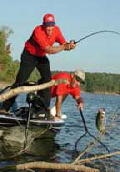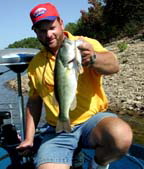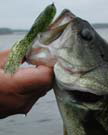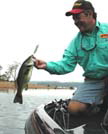|
Lake Ouachita's Creek Channel Challenge
Bass fishing the ledges in the Mountain Harbor area can be very productive!
By Larry Larsen
 "To find a pattern for bass in the fall, you will want to stay close to deep water," guide Chris Elder noted as
he moved to the bow trolling motor. "That's when shad move up in the creeks and bass will bunch in one place, like this one." "To find a pattern for bass in the fall, you will want to stay close to deep water," guide Chris Elder noted as
he moved to the bow trolling motor. "That's when shad move up in the creeks and bass will bunch in one place, like this one."
"Cast in that direction to the channel and work it into the bottom if you can," he directed. We can catch 20 or more bass quickly if the fish are on this spot."
Sure enough, we each immediately had a hook up and proceeded to put the feisty "double" aboard his bass boat. Releasing the two pounders, we again lofted our casts
toward the river bend in front of us. Within five minutes, we again had doubles, and over the course of the following hour, we landed and released 18 bass up to over four pounds each.
An outside bend in the creek channel turned around a point that had stumps on it, an
ideal spot on Lake Ouachita, according to the guide. Elder, of Mt. Ida, Arkansas, has been guiding bass and
striper anglers on the 40,000-acre lake for over 10 years. We had motored 10 minutes up river from our
base of operations at Mountain Harbor Resort. Elder quickly positioned his boat about 50 yards off one of the area's steeper banks, and we threw to the structure in 5 or 6 feet of water.
Autumn bass typically hang on the sheer dropoff, where a crankbait or Carolina-rigged worm is often
productive. Elder and I were using the Fat Free Shad crankbait and bumping it along the bottom through the
stumps to amass the big catch. We hit two more similar spots that morning and caught 8 largemouth on one
and 4 on the other. All of the fish were released back to their creek channel ledge habitats in the upper portion of Ouachita.
When looking for schools of fish in the fall on any reservoir, Elder recommends checking out submerged
creek channels first. If he had never fished the lake before, the guide would get a contour map and locate
the creek channels. His initial pattern development would consist of thoroughly fishing the entire area with a deep-running crankbait.
"Once you have located a bend in the creek channel, find a ledge," advises Elder. "It may take you half the
day to find 2 or 3 schools, but it will be worth it because the bass normally are concentrated on those spots
for a month or two in the fall and similarly in the early summer. The fish may move a little shallower or come out a little deeper due to fluctuations in water temperature."
 Threadfin shad tend to concentrate tightly in the cooler water, and that is where the bass will be. Two
weeks before my trip to fish Ouachita with Elder, the lake temperature was 87 degrees. When I arrived it had dropped to 74, much better for finding a
concentration of fall bass. Colder temperatures down in the 60's will bunch up scattered bass even better, according to the guide. Threadfin shad tend to concentrate tightly in the cooler water, and that is where the bass will be. Two
weeks before my trip to fish Ouachita with Elder, the lake temperature was 87 degrees. When I arrived it had dropped to 74, much better for finding a
concentration of fall bass. Colder temperatures down in the 60's will bunch up scattered bass even better, according to the guide.
"In November as the water cools down further, Ouachita bass will normally move from the mid-depth creek channels and suspend," says Elder. "They will be in
deeper water - 20 to 25 feet is the magic depth then - and a spoon will catch a larger-size bass. The deeper fish will still be around creek channel swings, but the
concentrations will be bigger. Vertical jig a 3/4 ounce jig or a small spoon and you will catch a lot of 2 to 3 pound fish."
Fish in the 48-year old lake typically move shallower in the springtime and at times
in December or January if the sun comes out. A rain in December and January causing any water flow or
color change will allow the fish to move against the rocks. When in they are in the dirtier water, they are
right up against the rocks; you can cast a red crankbait parallel to the rocks on the shoreline and catch a lot
of fish, according to the guide. You can catch fish on a spinnerbait, but the little red crankbait seems to work the best.
Moss and Brush Patterns
"Today, the middle portion of Ouachita is full of moss," says Elder. "Fifteen years ago, we would have
put out brush piles to concentrate bass, and they were productive. The brush piles now just do not
concentrate fish like they once did. Many fish now live in the moss, spawn in the moss, and feed in the moss
. The remaining bass, which are usually larger, live in the creek channels where there is no moss at all. They have enough cover there for the baitfish.
"When I fish the moss at night in June or July, I look for little points, indentions, or cutouts," says Elder.
"The fish will usually be laying right on the moss edge primarily in 12 to 18 feet of water. You may catch one
at a grass point or you may catch three or four. Try to key on the little indentions in the moss and use a big
worm or black spinnerbait. Rig the worm Texas-style with a 5/16th ounce weight on 20-pound test line and you're likely to catch a big fish in the dark."
 Daytime fishing depends on the weather conditions, according to Elder. If it is a bright, sunny day, a worm
will probably be the best bait, but if there is any discernible wind, it is best to use a jerkbait. A crankbait in the wintertime is effective if there is water over the moss. In
October, the moss is exposed and you have to go deep. In the springtime, Elder likes to throw the Fat Free Shad crankbait and a small Carolina-rigged Riverside worm. Daytime fishing depends on the weather conditions, according to Elder. If it is a bright, sunny day, a worm
will probably be the best bait, but if there is any discernible wind, it is best to use a jerkbait. A crankbait in the wintertime is effective if there is water over the moss. In
October, the moss is exposed and you have to go deep. In the springtime, Elder likes to throw the Fat Free Shad crankbait and a small Carolina-rigged Riverside worm.
In the springtime, bass will move in on the mossy and stump-laden points. Anglers should throw the Carolina rigged worm on the points and work it out to 12 feet depths.
Elder recommends starting at four feet using a jig head and small four-inch long worm or the Carolina rig. They will spawn in and behind the moss in an open water cut. Dirty
water coming in from a rain affects springtime fishing. When the water is 50 degrees in the creek and warm rainwater is coming in, Elder prefers a spinnerbait or a jerkbait.
Top Locations
Some of the better bassin' areas on Ouachita are Housley Point, a campground with two islands
surrounded by moss and the Southfork of the Ouachita River, particularly the Shangri La area. Surrounded
by the Ouachita Mountains, the deeper main body of the lake including the Three Fingers Bend area, the Highway 27 bridge area and Muddy Creek are all good places to fish.
"In Muddy Creek, fishing the little channel bends that have a point where the current hits," says Elder.
"The current deposits a bunch of leaves in what we call leaf beds, and that's where the fish hang out. That
is a fall pattern. Then in the spring, you would fish the points that have the jagged rock exposed with dead worm, crankbait or a Carolina rig."
After the weather cools from November on, most areas between Brady Mountain and the dam is good. The
mossy, dropoff areas near Mountain Harbor are best in the cooler water. The jerkbait is effective year around in the right depth of moss.
Big Fish Bite
Elder's biggest Ouachita fish was a 9-pound, 2-ounce largemouth caught about 11 years ago, but friend
Mark Davis caught a 12-pound 2-ounce bass in a night tournament last June 2000. He fished a black
spinnerbait in four foot of water on a shallow point that was full of stumps. The fish was still spawning.
 Fishing with friends Davis and Bruce Stanton of PRADCO lures, Elder had one very memorable day fishing
the moss just north of Mount Harbor on a cloudy, hazy day. They were near Housley Point at a place they call Well Point. All three were fishing Super Rogue minnow baits
when they got into several giant bass. They caught 8 five pounders, 5 four pounders and Elder caught one over six pounds that one day. The conditions were reportedly just right. Fishing with friends Davis and Bruce Stanton of PRADCO lures, Elder had one very memorable day fishing
the moss just north of Mount Harbor on a cloudy, hazy day. They were near Housley Point at a place they call Well Point. All three were fishing Super Rogue minnow baits
when they got into several giant bass. They caught 8 five pounders, 5 four pounders and Elder caught one over six pounds that one day. The conditions were reportedly just right.
The lake record striper weighed 34 pounds. To catch the giants, most avid striper chasers fish live shad deep near the dam. Elders biggest one was a 25 pounder that he
landed on six-pound test line. The fish swam around for quite a while in deep timber.
The best time for big stripers is the end of October through December. The stripers will
move to shallower areas of the lake with just a small decrease in water temperature. The best temperature
is usually in the fifties or low sixties. Stripers move from the dam in 60 feet of water up the lake staying close to the deep water and the black timber where the water's cooler.
Trip Information
The optimal time to plan a trip to fish Lake Ouachita is in the late spring or fall if you want to catch a lot of
fish, according to the guide. There are 10 public ramps and three nice resorts on the lake. There are six
different striper guide services and 8 guides, including Chris Elder, that fish both largemouth and stripped
bass from the Hugh Albright Guide Service. To book a trip or for information, contact them at (501) 767-2171.
The ideal place to stay is at the modern and very comfortable Mountain Harbor Resort about 25 miles west
of Hot Springs Arkansas. It has the best marina and restaurant on the lake and offers a variety of cozy
accommodations including campsites, motel rooms, new condominiums and cottage duplexes with multiple
bedrooms. They also offer plush houseboat rentals, riding stables, a scuba diving center and the typical resort recreation amenities like a swimming pool.
For more information, Contact Mountain Harbor Resort, P.O. Box 1268, Mount Ida, AR 71957 or phone (800)
832-2276 or (870) 867-1200. Their email is mtharbor@ipa.net and website is www.mtharbor.com. Click if you want help with flights to the area.
|